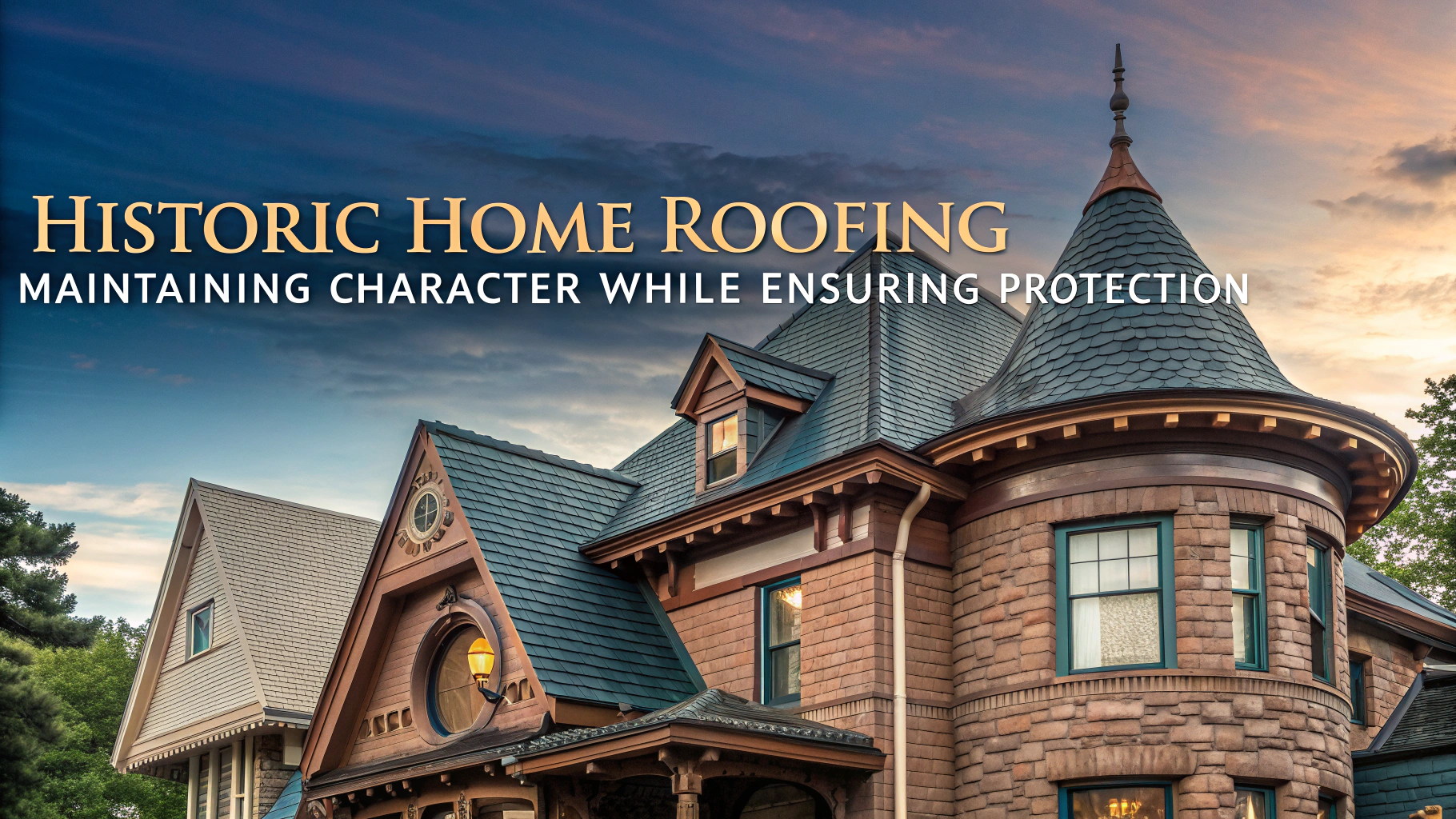Historic homes stand as architectural treasures that tell stories of our past through their unique design elements, craftsmanship, and character-defining features.
The roof of a historic home serves as both its crown and its primary defense against the elements, making proper maintenance and restoration essential for preserving these architectural gems.
This guide explores how to maintain the historical integrity of your home’s roof while ensuring it meets modern protection standards.
Common Historic Roofing Materials
- Slate – Natural stone tiles known for durability (75-200 years lifespan)
- Clay Tiles – Distinctive terra cotta roofing (50-100 years)
- Wood Shingles – Cedar or redwood shakes (20-40 years)
- Metal – Copper, tin, or terne-coated steel (50+ years)
Preserving Historical Authenticity
Document your roof’s original materials, patterns, and details through photographs and measurements before starting any work.
Contact your local historic preservation office to understand regulations and requirements for roof modifications.
Work with contractors who specialize in historic preservation and have experience with period-appropriate materials.
Modern Solutions for Historic Roofs
- Synthetic slate alternatives that maintain appearance while offering improved durability
- Hidden reinforcement systems that preserve aesthetics while adding structural support
- Modern underlayment materials that enhance weather protection
- Energy-efficient insulation solutions that don’t compromise historical character
Maintenance Tips for Historic Roofs
- Inspect roofing twice yearly, particularly after severe weather
- Clear gutters and downspouts monthly
- Address repairs promptly to prevent water damage
- Keep detailed maintenance records
- Schedule professional inspections annually
Finding Qualified Contractors
Look for contractors certified by the National Roofing Contractors Association (NRCA) with specific historic preservation experience.
Request references from previous historic restoration projects and verify their insurance coverage.
Contact the Historic Preservation Office in Colorado at (303) 866-3395 for recommended contractors.
Cost Considerations and Funding
- Federal Historic Preservation Tax Credits (20% for qualified rehabilitation)
- State historic preservation grants
- Local preservation society funding programs
- Historic home insurance policies with restoration coverage
Ensuring Long-Term Protection
Regular maintenance and proactive repairs help preserve both the historical significance and structural integrity of your historic home’s roof.
Document all restoration work for future reference and maintain detailed records of materials used.
Consider installing modern moisture monitoring systems to detect potential issues early.
Weather Protection Strategies
- Install proper ventilation systems to prevent moisture buildup
- Apply period-appropriate flashing materials around chimneys and valleys
- Use breathable waterproof membranes beneath historic materials
- Implement ice and snow management systems in cold climates
Emergency Response Planning
Create an emergency response plan for severe weather events, including:
- Contact information for emergency restoration services
- Temporary protection measures and materials
- Documentation procedures for insurance claims
- Evacuation protocols to protect valuable architectural elements
Sustainable Preservation Practices
Energy Efficiency
- Install radiant barriers in attic spaces
- Use period-appropriate insulation materials
- Incorporate passive ventilation systems
Environmental Considerations
- Source sustainable replacement materials
- Recycle original materials when possible
- Use eco-friendly cleaning and preservation products
Preserving Tomorrow’s Heritage Today
Maintaining historic roofs requires a delicate balance between preservation and protection. By following proper maintenance procedures, working with qualified professionals, and implementing appropriate modern solutions, homeowners can ensure their historic roofs continue to protect and enhance their properties for generations to come.
Remember that each preservation project contributes to maintaining our architectural heritage and helps tell the story of our communities’ past, present, and future.
Stay connected with local preservation societies and continue educating yourself about emerging preservation techniques and resources to maintain your historic roof’s integrity for years to come.
FAQs
- What are the most common roofing materials used in historic homes?
Slate, clay tiles, wood shakes, metal (copper, tin, or terne), and original asphalt shingles are the most common historic roofing materials. - How can I maintain the historical authenticity of my roof while ensuring modern protection?
Use historically accurate materials, work with preservation specialists, maintain original patterns and details, and incorporate modern underlayment and ventilation systems beneath the visible roofing material. - Are there specific regulations for replacing historic home roofs?
Yes, homes listed on historic registers often require approval from preservation boards and must comply with local historic district guidelines for materials, colors, and patterns. - What’s the lifespan of traditional historic roofing materials?
Slate can last 75-200 years, clay tiles 50-100 years, copper 70+ years, wood shakes 20-40 years, and traditional tin roofing 40-50 years with proper maintenance. - How do I find contractors qualified to work on historic roofs?
Look for contractors certified in historic preservation, members of preservation organizations, and those with documented experience working with historic properties and traditional materials. - What modern improvements can be incorporated without compromising historical integrity?
Modern underlayments, ice and water shields, proper ventilation systems, and hidden fastening systems can be added while maintaining historic appearance. - Can damaged historic roofing materials be repaired rather than replaced?
Yes, individual slate tiles, clay tiles, or metal panels can often be repaired or selectively replaced by skilled craftsmen without requiring a full roof replacement. - How do seasonal weather changes in Colorado affect historic roofing materials?
Extreme temperature fluctuations, heavy snow loads, intense UV exposure, and hail require special consideration for material selection and regular maintenance of historic roofs in Colorado. - What are the cost implications of maintaining a historic roof versus modern alternatives?
Historic roofing materials typically cost 2-3 times more initially but often last significantly longer and maintain the home’s historical value better than modern alternatives. - How often should historic roofs be inspected?
Professional inspections should be conducted twice yearly – spring and fall – with additional checks after severe weather events.
